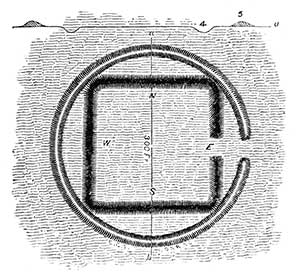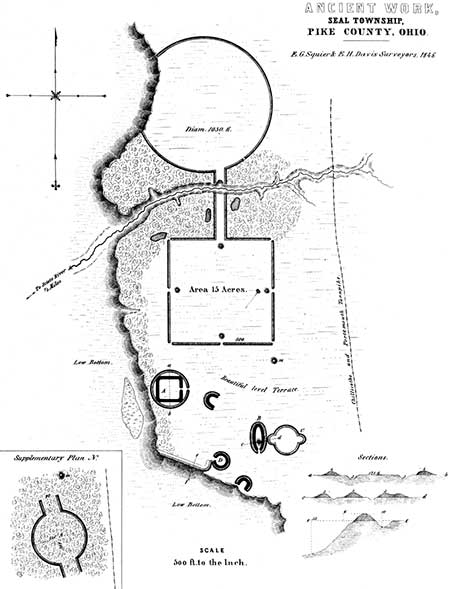PLATE XXIV.
Ancient Works, Pike County, Ohio.
THE plan so fully illustrates the character of this group of works, that little description is necessary. It consists principally of the constantly recurring figures, the square and the circle; the former measuring in this instance a little upwards of eight hundred feet upon each side, the latter ten hundred and fifty feet in diameter. They are connected by parallel walls, four hundred and seventy-five feet long, placed one hundred feet apart. These are intersected by a runway, which has here cut a passage in the terrace one hundred and twenty-five feet wide, by fifteen deep. This gully or ravine was undoubtedly in existence at the period of the construction of the works. The banks between the parallels appear to have an offset, as if they had been artificially graded; no further indications of a grade now exist.
 |
| Figure 11. |
The walls of the square coincide very nearly with the cardinal points of the compass, varying therefrom but three degrees. This is, however, an accidental coincidence; as all the ancient works seem to have been made to conform to the position of the ground which they occupy. There is no evidence that any regard was had to the points of the compass, except that the gateways or openings of the small circles are oftenest towards the east.
About one mile to the northward of this group is the unique work shown in the supplementary plan N. Its walls are about four feet high, and its outlines beautifully distinct54
It is impossible to resist the conviction that some significance attaches to these singular forms.
54. There are some singular structures in Sweden, which coincide very nearly with this remarkable little work. They are circles composed of upright stones, having short avenues of approach upon each side, opposite each other, in the manner here represented. See Sjöborg's Samlingar for Nordens Fornälskare, 1822.


